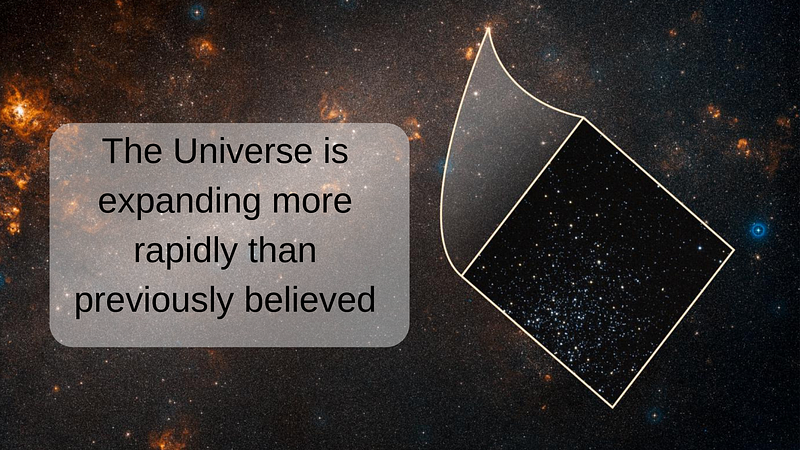The Rapid Expansion of the Universe: Insights from Hubble
Written on
Chapter 1: Understanding Universal Expansion
Recent discoveries indicate that the Universe is expanding at a significantly faster rate than earlier estimates suggested. According to new data from the Hubble Space Telescope, astronomers now believe that the Universe is expanding approximately 9% quicker than anticipated, based on observations from shortly after the Big Bang.
This discrepancy points to the need for a revision of the Hubble constant (H0)—the metric used to measure the current rate of the Universe's expansion, named after Edwin Hubble, who first identified this phenomenon. The current figure of approximately 2 x 10^-18 s^-1 may no longer suffice.
Adam Riess, Bloomberg Distinguished Professor of Physics and Astronomy at Johns Hopkins University and a Nobel Laureate, notes the growing gap between previous calculations and new findings: “This inconsistency has been escalating and has reached a level that is difficult to disregard as mere coincidence. This is unexpected.”
The latest findings, published on April 25 in the Astrophysical Journal Letters, have significantly reduced the likelihood that this disparity is a random occurrence, dropping from 1 in 3,000 to just 1 in 100,000. This suggests that we might need to explore new physics to better comprehend the cosmos.
Section 1.1: The Method Behind the Measurements

Astronomers employ a systematic approach to determine the rate at which the Universe expands over time, known as the Hubble constant. This process involves constructing a robust “cosmic distance ladder,” beginning with precise distance measurements to nearby galaxies and progressively extending to more distant ones. This ladder consists of a series of measurements utilizing various astronomical objects with known brightness to calculate distances (NASA, ESA, and A. Feild (STScI)).
In this study led by Riess and his team known as SH0ES (Supernovae, H0, for the Equation of State), they analyzed light from 70 stars located in our neighboring galaxy, the Large Magellanic Cloud. Utilizing a new technique, they were able to capture rapid images of these stars—specifically Cepheid variables, which exhibit predictable patterns of brightening and dimming. This regularity makes them ideal for measuring intergalactic distances.
Traditionally, measuring these stars is a labor-intensive process, with Hubble only able to observe one star per 90-minute orbit. However, using their innovative approach called DASH (Drift And Shift), the team transformed Hubble into a ‘point-and-shoot’ camera, enabling them to capture images of multiple Cepheids simultaneously.
This new data empowered Riess and SH0ES to bolster the cosmic distance ladder, facilitating accurate distance measurements within the Universe and refining the Hubble constant.
The first video titled "The Universe is Expanding Faster Than We Thought, Here Is Maybe Why" delves into the implications of these findings, highlighting how they could reshape our understanding of cosmic expansion.
Section 1.2: Collaborative Efforts and Enhanced Accuracy
By combining their Hubble measurements with additional observations from the Araucaria Project—a collaboration involving astronomers from Chile, the U.S., and Europe—the team made further distance measurements to the Large Magellanic Cloud. This was achieved by observing the dimming of light when one star eclipses another in binary systems.
These combined measurements allowed the SH0ES team to refine the true brightness of the Cepheids. With this more accurate data, they were able to “tighten the bolts” of the distance ladder, which extends into deeper space using supernova observations.
Despite improved precision in their measurements, the Hubble constant calculated by the SH0ES team continues to conflict with values derived from the European Space Agency’s Planck satellite, which based its calculations on early universe expansion observed 380,000 years post-Big Bang.
The second video titled "The Expansion of the Universe, Faster Than We Thought (Adam Riess)" presents a comprehensive overview of this ongoing research and the potential implications for our understanding of the Universe.
Continuing to address the significance of this mismatch, Riess emphasizes: “This is not merely two experiments showing disagreement. We are measuring something fundamentally different. One measurement reflects the current expansion rate of the Universe, while the other is a prediction based on early universe physics.”
While Riess does not yet have a definitive explanation for the observed discrepancy, he and the SH0ES team are committed to refining the Hubble constant, aiming to minimize uncertainty to 1%. Their recent measurements have reduced uncertainty from 10% in 2001 to 5% in 2009, and now to 1.9%.
Riess concludes with a crucial insight for science and our understanding of the Universe: “If these values do not align, it strongly suggests that we are overlooking essential elements within the cosmological model that bridges these two epochs.”